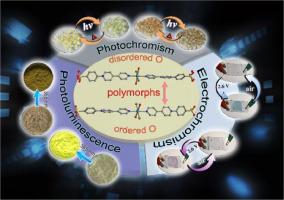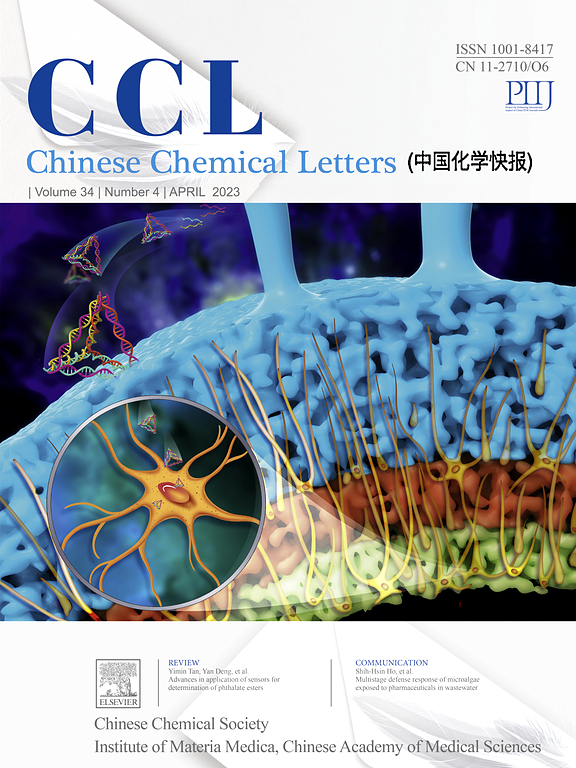Tuning up of chromism, luminescence in cadmium-viologen complexes through polymorphism strategy: Inkless erasable printing application
IF 9.4
1区 化学
Q1 CHEMISTRY, MULTIDISCIPLINARY
引用次数: 0
Abstract
In our work, polymorphism strategy has been successfully applied to tune up chromism and luminescence properties of viologen-based materials. Two polymorphs of viologen-based complexes of α-CdBr2(PHSQ)2(H2O)2 (1) and β-CdBr2(PHSQ)2(H2O)2 (2) (PHSQ = N-(4-sulfophenyl)-4,4′-bipyridinium) were synthesized by changing the solvent. They can both respond to UV light and electricity in the manner of chromism visible to the naked eye and the coloration states have good reversibility, through which an inkless erasable printing model has been established. But the coloration contrast of 1 is higher compared to 2. Meanwhile, they both exhibit photoluminescence properties and the intensity of 1 is twice that of 2, which is accompanied by photoquenching upon continuous UV light irradiation. The only divergence of disordered/ordered O atoms in the two crystalline compounds leads to significantly different chromic and luminescent properties. Further explorations simultaneously demonstrate that the different chromic performance between 1 and 2 should attribute to the alteration of stimulus-induced (light/ electricity) electron transfer channels caused by the ordered/disordered O atoms in the complexes, which is achieved through C![]() H···O and O
H···O and O![]() H···O interactions to change crystal arrangement and structural rigidity, thus affect luminescent properties.
H···O interactions to change crystal arrangement and structural rigidity, thus affect luminescent properties.

通过多态性策略提高镉-viologen 复合物的色度和发光性能:无墨可擦除印刷应用
在我们的工作中,多态性策略已被成功应用于调整紫光素基材料的色度和发光特性。通过改变溶剂,我们合成了 α-CdBr2(PHSQ)2(H2O)2 (1) 和 β-CdBr2(PHSQ)2(H2O)2 (2)(PHSQ = N-(4-磺酸苯基)-4,4′-联吡啶鎓)两种多形态的紫外络合物。它们都能以肉眼可见的发色方式对紫外光和电产生反应,且发色状态具有良好的可逆性,从而建立了一种无墨可擦除印刷模型。同时,它们都具有光致发光特性,1 的强度是 2 的两倍,在连续紫外光照射下会发生光淬灭。这两种晶体化合物中无序/有序 O 原子的唯一差异导致其色度和发光特性大不相同。进一步的探索同时证明,1 和 2 之间不同的色度性能应归因于复合物中有序/无序 O 原子导致的刺激诱导(光/电)电子传递通道的改变,这种改变是通过 CH-O 和 OH-O 相互作用来实现的,从而改变晶体排列和结构刚性,进而影响发光特性。
本文章由计算机程序翻译,如有差异,请以英文原文为准。
求助全文
约1分钟内获得全文
求助全文
来源期刊

Chinese Chemical Letters
化学-化学综合
CiteScore
14.10
自引率
15.40%
发文量
8969
审稿时长
1.6 months
期刊介绍:
Chinese Chemical Letters (CCL) (ISSN 1001-8417) was founded in July 1990. The journal publishes preliminary accounts in the whole field of chemistry, including inorganic chemistry, organic chemistry, analytical chemistry, physical chemistry, polymer chemistry, applied chemistry, etc.Chinese Chemical Letters does not accept articles previously published or scheduled to be published. To verify originality, your article may be checked by the originality detection service CrossCheck.
 求助内容:
求助内容: 应助结果提醒方式:
应助结果提醒方式:


